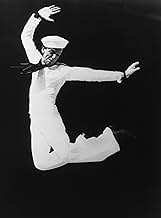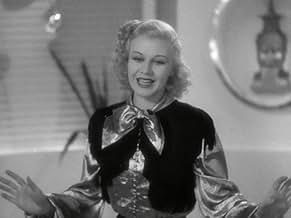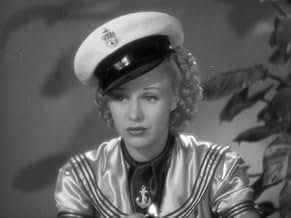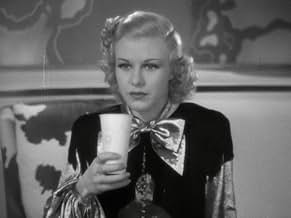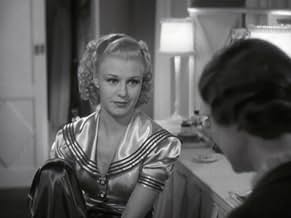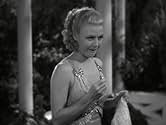AVALIAÇÃO DA IMDb
7,1/10
4,9 mil
SUA AVALIAÇÃO
Adicionar um enredo no seu idiomaA Navy sailor tries to rekindle a romance with the woman he loves while on liberty in San Francisco.A Navy sailor tries to rekindle a romance with the woman he loves while on liberty in San Francisco.A Navy sailor tries to rekindle a romance with the woman he loves while on liberty in San Francisco.
- Direção
- Roteiristas
- Artistas
- Prêmios
- 4 vitórias e 2 indicações no total
Harriet Nelson
- Connie Martin
- (as Harriet Hilliard)
Jean Acker
- Minor Role
- (não creditado)
Richard Alexander
- Paradise Ballroom Waiter
- (não creditado)
Constance Bergen
- Ticket Seller
- (não creditado)
Frederic Blanchard
- Captain Jones
- (não creditado)
Lynton Brent
- Deck Officer
- (não creditado)
Phyllis Brooks
- Minor Role
- (não creditado)
Tom Brower
- Policeman
- (não creditado)
Avaliações em destaque
This is my all-time favorite Fred Astaire and Ginger Rogers film. The dialogue between the two is so cute and funny and very clever. Not to mention this film contains some of the best songs recorded by the two; like I'm Putting All My Eggs in One Basket and Let's Face the Music and Dance. If I remember correctly, this was the film that introduced me to Fred Astaire so I suppose because of that it will always hold a special place in my heart (sorry for the sentimental cr*p but I'm woman so get over it)All in all this film gets an 8/10 from me. The choreography was superb and also the fact that Lucille Ball is in it makes it even more awesome.
Musically speaking Irving Berlin gave Fred Astaire and Ginger Rogers another pluperfect musical after Top Hat if that was possible. Although in this case like that Jerome Kern confection Roberta that they were in, Follow the Fleet retained Randolph Scott with another singer, this time Harriet Hilliard.
Randolph Scott is a career Navy CPO and Fred Astaire is an ex-vaudevillian who enlisted in the Navy to forget Ginger Rogers his former partner. But now the two are on shore leave. Fred and Ginger take up right where they left off, and Randy accidentally meets Ginger's dowdy sister Harriet who blossoms into a real beauty. But Randy's a typical love 'em and leave 'em sailor.
Again Irving Berlin wrote a hit filled score with him tightly supervising the production. Ginger gets to do some really outstanding vocalizing with Let Yourself Go which she and Fred later dance to. But the real hit of the show is Let's Face the Music and Dance which is a number done at a Navy show. Sung first by Astaire and later danced to by the pair, Let's Face the Music and Dance is one of the great romantic numbers ever written for the screen. Their dancing on this one is absolute magic.
I'm sure that when I mention Harriet Hilliard a few younger people might ask who that was. But they will know immediately when I mention her in conjunction with her famous husband Ozzie Nelson. That's right Ozzie and Harriet. It's something of a mystery to me why Harriet stopped singing when she just became David and Ricky's mom on television. Then again she didn't even keep her own name.
Neither Ozzie or Harriet sang on television. Ozzie was a pale imitation of Rudy Vallee as a singer, but Harriet could really carry a tune. She sings Get Thee Behind Me Satan and The Moon and I Are Here, But Where Are You, both with real feeling and class. I recommend you see Follow the Fleet if for no other reason than to hear a dimension of Harriet Hilliard incredibly forgotten today.
Randolph Scott is a career Navy CPO and Fred Astaire is an ex-vaudevillian who enlisted in the Navy to forget Ginger Rogers his former partner. But now the two are on shore leave. Fred and Ginger take up right where they left off, and Randy accidentally meets Ginger's dowdy sister Harriet who blossoms into a real beauty. But Randy's a typical love 'em and leave 'em sailor.
Again Irving Berlin wrote a hit filled score with him tightly supervising the production. Ginger gets to do some really outstanding vocalizing with Let Yourself Go which she and Fred later dance to. But the real hit of the show is Let's Face the Music and Dance which is a number done at a Navy show. Sung first by Astaire and later danced to by the pair, Let's Face the Music and Dance is one of the great romantic numbers ever written for the screen. Their dancing on this one is absolute magic.
I'm sure that when I mention Harriet Hilliard a few younger people might ask who that was. But they will know immediately when I mention her in conjunction with her famous husband Ozzie Nelson. That's right Ozzie and Harriet. It's something of a mystery to me why Harriet stopped singing when she just became David and Ricky's mom on television. Then again she didn't even keep her own name.
Neither Ozzie or Harriet sang on television. Ozzie was a pale imitation of Rudy Vallee as a singer, but Harriet could really carry a tune. She sings Get Thee Behind Me Satan and The Moon and I Are Here, But Where Are You, both with real feeling and class. I recommend you see Follow the Fleet if for no other reason than to hear a dimension of Harriet Hilliard incredibly forgotten today.
Had this film been put together a tad better, it would be up there with the best of Astaire and Rogers. As it is, it's a fine movie but overly long with a tedious subplot, i.e., Randolph Scott romancing Rogers' sister, played by Harriet Hilliard (that's Ozzie Nelson's wife to you baby boomers).
Astaire and Scott are two Navy men. Scott meets Hilliard the first time when she looks like a stereotypical librarian, and later on after Ginger Rogers has asked her friend (a blond but unmistakable Lucille Ball) to glamor her up.
Meanwhile, Astaire tries to pick up where he and his old dancing partner left off. The result is some wonderful dance numbers, with Astaire and Rogers as a team as well as separately: "I'm Putting All My Eggs in One Basket," "Let Yourself Go," and "I'd Rather Lead the Band."
Hilliard is sweet but a little lethargic as a plain Jane turned glamor girl, although she sings her two songs well, "But Where Are You?" and "Get Thee Behind Me, Satan" - one poster didn't care for that song, but I love the title. Rogers is vivacious, and a youthful Astaire is a dynamo.
The highlight of the movie comes at the end with "Let's Face the Music and Dance," one of the most achingly beautiful songs ever written and certainly one of the most brilliantly executed by Rogers and Astaire. In it, they epitomize '30s glamor and fantasy. It is truly to be treasured and watched again and again.
Astaire and Scott are two Navy men. Scott meets Hilliard the first time when she looks like a stereotypical librarian, and later on after Ginger Rogers has asked her friend (a blond but unmistakable Lucille Ball) to glamor her up.
Meanwhile, Astaire tries to pick up where he and his old dancing partner left off. The result is some wonderful dance numbers, with Astaire and Rogers as a team as well as separately: "I'm Putting All My Eggs in One Basket," "Let Yourself Go," and "I'd Rather Lead the Band."
Hilliard is sweet but a little lethargic as a plain Jane turned glamor girl, although she sings her two songs well, "But Where Are You?" and "Get Thee Behind Me, Satan" - one poster didn't care for that song, but I love the title. Rogers is vivacious, and a youthful Astaire is a dynamo.
The highlight of the movie comes at the end with "Let's Face the Music and Dance," one of the most achingly beautiful songs ever written and certainly one of the most brilliantly executed by Rogers and Astaire. In it, they epitomize '30s glamor and fantasy. It is truly to be treasured and watched again and again.
One of several musicals about sailors on leave, it is the usual sailor meets girl, complications ensue, sorted out happily kind of plot. It proceeds along smoothly enough but it does drag in places too. The dialogue is not as zippy as 'Top Hat' for example and Randolph Scott seems out of place.
There are compensations. It has some of Irving Berlin's choicest songs including 'Let Yourself Go', 'I'm Putting all My Eggs in One Basket' and 'Let's Face the Music and Dance'. It has Fred and Ginger who when they are dancing take any film into heavenly heights and they don't disappoint here. They do a snappy tap dance, a knockabout comic dance and a swirling graceful dance, all in the same film! Great versatility and artistry.
It also has Harriet Hilliard who is rather good in her role. She had a varied career, becoming the more famous Harriet Nelson with Ozzie. Here she is touching without being sentimental.Her two songs are simply and effectively delivered. She makes a good contrast with Ginger but you can believe they are sisters in the film.
More tightening up have made the film even better. Pretty good though.
There are compensations. It has some of Irving Berlin's choicest songs including 'Let Yourself Go', 'I'm Putting all My Eggs in One Basket' and 'Let's Face the Music and Dance'. It has Fred and Ginger who when they are dancing take any film into heavenly heights and they don't disappoint here. They do a snappy tap dance, a knockabout comic dance and a swirling graceful dance, all in the same film! Great versatility and artistry.
It also has Harriet Hilliard who is rather good in her role. She had a varied career, becoming the more famous Harriet Nelson with Ozzie. Here she is touching without being sentimental.Her two songs are simply and effectively delivered. She makes a good contrast with Ginger but you can believe they are sisters in the film.
More tightening up have made the film even better. Pretty good though.
This film is nice because there are two love stories-- something of a plot departure, and the second couple (Randolph Scott and Harriet Hilliard Nelson) are given the bulk of the dramatics, which allow our stars to be looser, more comical. Astaire chews the gum a little too severely, but he was anxious to make a departure from his customary tuxedoed playboy. Rogers is much more at ease in the role of struggling dancer-singer, and plays well opposite sister Hilliard. (The history is that Ms. Hilliard had to darken her naturally blond hair to distinguish her from Ms. Rogers. But wouldn't they better resemble sisters if they were both blonds?) The Irving Berlin numbers are quite good, ranging from light and airy ("Let Yourself Go," "I'd Rather Lead A Band") to elegant ("Let's Face The Music And Dance"). This final number is the film's bewitching finale, performed on a lovely Art-Deco rooftop and illustrates Astaire's penchant for full-frame, single-take dancing. It is, in a nutshell, singularly gorgeous. The trivia history goes that Rogers' metallic thread gown had weights in the sleeves and hem to make the skirt wind and unwind; the dress was unintentionally difficult to perform in because its flared sleeves hit Astaire across the face IN THE FIRST TAKE- and after many re-shoots trying to cover it up, they ended up printing that first take (we have to assume that was apparently the best performance of the dance, but you can see the sleeves brush across Astaire's face). It loses one-half point from me, because Randolph Scott says 'bebby' once too often.
Você sabia?
- CuriosidadesDuring the fight scene between Fred Astaire and Randolph Scott, Astaire - not skilled in movie fight scenes - accidentally bloodied Scott's nose; Astaire was mortified, but Scott remained pointedly nonchalant.
- Citações
Sherry Martin: Look, why don't you let me try to fix you up? You'll be amazed how much better it will make you feel.
Connie Martin: Even though I'm not a blonde, I could be dumb, couldn't I?
Sherry Martin: And you'll probably do all right too. It takes a lot of brains to be dumb.
- ConexõesFeatured in Fred Astaire: Puttin' on His Top Hat (1980)
- Trilhas sonorasWe Saw the Sea
(uncredited)
Written by Irving Berlin
Played during the opening credits
Performed by Fred Astaire and chorus
[Also played as dance music]
Principais escolhas
Faça login para avaliar e ver a lista de recomendações personalizadas
- How long is Follow the Fleet?Fornecido pela Alexa
Detalhes
- Data de lançamento
- País de origem
- Idiomas
- Também conhecido como
- Follow the Fleet
- Locações de filme
- Empresa de produção
- Consulte mais créditos da empresa na IMDbPro
Bilheteria
- Orçamento
- US$ 747.000 (estimativa)
- Tempo de duração1 hora 50 minutos
- Cor
- Proporção
- 1.37 : 1
Contribua para esta página
Sugerir uma alteração ou adicionar conteúdo ausente

Principal brecha
By what name was Nas Águas da Esquadra (1936) officially released in India in English?
Responda

